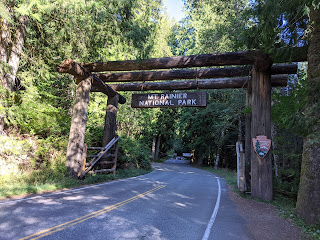August 30, 2020 Sunday
We awakened at a reasonable hour and ate a minimal breakfast out of our food stock. Not very hungry after the diner excesses from the prior two nights in Riggins. As I was walking through the launderette loading the car the owner was laundering sheets and towels. I had an interesting talk with him about the town. He has lived there for 27 years after moving from California. Said that the latter was too crowded, too expensive and the taxes were too high. He liked his current peace and quiet and bemoaned the current violence in the "big cities" which he attributed to "agitators and socialists". He opined that he through that Trump was the right man to save the country. When i pointed out that Trump was incompetent, corrupt and lawless, he dismissed that as fake news. However it was friendly, civil, albeit fact free discussion. A couple who were apparently waiting for their laundry voiced agreement with those conclusions while they were smoking up a storm. I threw a ball for the owner's dog and couldn't stop him from repeatedly returning the ball and expecting me to throw it. That occurred even when I threw the ball as far as I could. The owner said that there was plenty of business for him because the main road to Canada ran through the town (there was only one main road US route 95, in town.), even in the winter because there was very little snow in town and plenty of hunting and fishing. He also claimed that the town is the white water capital of Idaho.
Our motel in Riggins, IDWe departed about 9:15 am. The road ran along the Little Salmon River. There were warning signs when we arrived two days prior that the road was closed and the employee on the raft said that the road closure had cut her off from her home, but I was not prepared for the extent of the rock slide that caused the detour. Massive piles of rock covered the roadway and there were large front loaders and dump trucks lifting and carrying them away even on a Sunday morning. The rock slide had occurred over a month ago and I later viewed videos of it on YouTube. The detour took us on Pollack Road, a narrow, barely two lane road which paralleled the river and the closed route 95 and ran through several small towns including Pollack. Many of the houses we passed were older and not well maintained, but there were more than a few larger and beautiful homes along the road. We were part of a slow moving caravan that included many large tractor trailer and RVs. When we returned to route 95 after the 35 minute detour we remained part of a parade of vehicles following slow moving RVs whose drivers declined to pull over in the slow moving vehicle pullouts to allow other vehicles to pass. Because route 95 is a windy road there were infrequent opportunities to pass. On the plus side the slow speed enabled me to observe the gorgeous mountain scenery and the river and frequent white water rapids that paralleled the drive.
Traffic finally picked up after about 1.5 hours as we emerged from the mountains and into the flat lands which surround Boise. Farms gave way to suburban tracts and we gassed up outside of Boise.
We then began the final, boring interstate highway portion of the trip which took us on I-84 in a southeast direction through southern Idaho and into Utah for a few hundred miles. Lots of empty space with large tumbleweeds dancing across the road and sticking to our car.
Remains of tumbleweeds stuck in our car grillAfter several hundred miles and hours of driving we stopped for dinner and electric charging in Tremonton UT, located near the intersection of I -84 and 15. I selected this stopping point because amazingly it had not one, but two free public charging stations. The town is in the center of the Bear River Valley (however the Malad River flows through the town) and has less than 10,000 residents. It was settled initially by Mormons in the late 19th century, but then came a wave of mid-western emigrant Protestant farmers who named the town after Tremont, Illinois. (I had hoped it was named after Tremont Ave in the Bronx). They were referred to as the "German Colony".
We parked and plugged in at the charging station behind the police station and began a search for a restaurant. It was late, hot, Sunday afternoon. Nothing was open and there was very little pedestrian or vehicular traffic. We finally found an open grocery store where we purchased sandwiches and snacks which we took over to Sherman Park, the location of the other charging station. We ate at a gazebo which thankfully shielded us from the sun and were surrounded by a birthday party of Hispanic families. I briefly spoke with them and learned that farming and the the Malt-O-Meal factory were the area's major employers. No one we saw in town was wearing a mask.
We unplugged the car with 18 miles of electricity, gassed up too and arrived back in SLC in the early evening. Still daylight so I went over to the condo to water the tomato plants and harvest some ripe ones.


















































